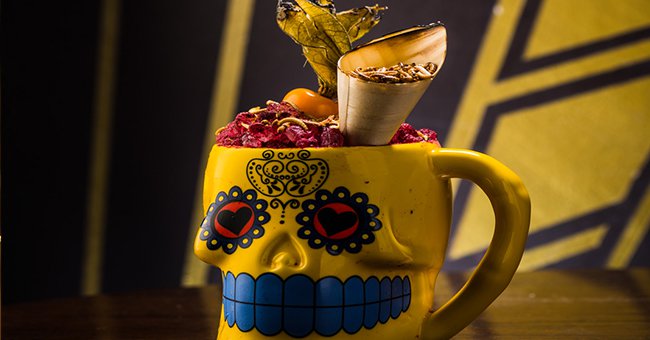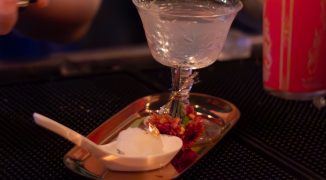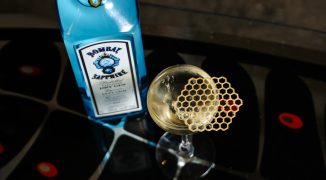Internationally, cocktail bars are putting more emphasis than ever on the garnish. Whether simple or ornate, bartenders, managers, owners, and imbibers agree that a garnish ought to be aromatically and aesthetically appealing. To that end, Latitude 29 owner and tiki master Jeff “Beachbum” Berry, Diane Corcoran of Three Dots and a Dash, and London’s Bar Nightjar owner Edmund Weil have all spent countless hours perfecting the garnishes that sit atop their equally impressive drinks.
According to Jeff “Beachbum” Berry, there are four things to think about when it comes to cocktail garnishes. “First,” he says, “is the look. If it doesn’t look good it will turn someone off. Secondly, it’s got to compliment and enhance the flavors of the drink, either by matching the flavors, or working in counterpoint — like sweet and sour work in a chef’s dish. Third: it should be engineered so that it can be done quickly and is structurally sound.” In other words — you don’t want it to fall off the glass. Lastly, says Berry, the garnish can’t be neglected. “Two mistakes often made are under-garnishing, and not garnishing thoughtfully.”
Bar Nightjar’s garnish philosophy is in concert with thoughtfulness. The team spends hours in creative meetings, with garnishes as a key discussion point. “We do a full revamp of our menu every year and every six months we change ten drinks or so,” says owner Edmund Weil. “There’s a lot of discussion, but also experimentation. Our bartenders are often experimenting and trying something new on a cocktail.”
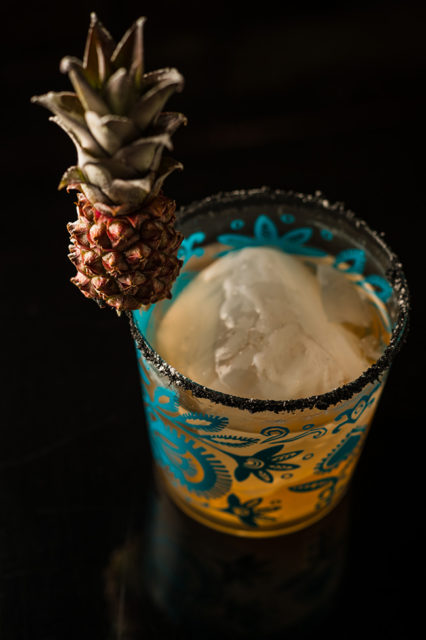 Bar Nightjar’s Barrel-Aged Pina Colada is garnished with a mini pineapple — discovered by a Nightjar bartender on an early morning trip to the flower market. Photo by Addie Chin.
Bar Nightjar’s Barrel-Aged Pina Colada is garnished with a mini pineapple — discovered by a Nightjar bartender on an early morning trip to the flower market. Photo by Addie Chin.
Weil also credits his bartenders’ gung-ho garnish attitudes for the success of the bar and its creativity. “The culture of our bar now is that every drink is expected to have a creative edge.” Bar Nightjar’s Barrel-Aged Pina Colada is garnished with a mini pineapple — discovered by a Nightjar bartender on an early morning trip to the flower market. “Sometimes our bartenders go to the flower market early in the morning, after their shift, and pick up all of the good stuff to experiment with before anyone else has seen it.”
Bar Nightjar also employs garnishes that are not meant to be ingested, such as in the Forager’s Shrub, which appears before patrons in a double-chambered vessel. In the largest chamber is the drink, while the smaller, interior chamber houses an aromatic saffron oil. By adding a tiny amount of dry ice to the saffron oil, the small chamber becomes an aromatizer. “The effect of the smoke coming out is brilliant,” says Weil. “But, it has functions beyond theater. The great thing about dry ice is that it’s very, very cold, so it cools the drink without adding ice, and it brings out the aromatics.”
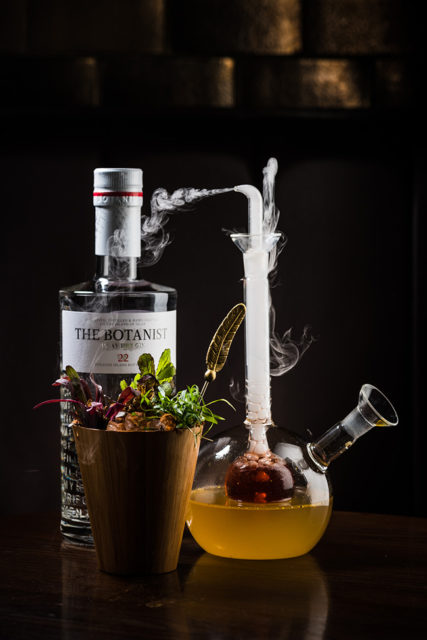 Bar Nightjar’s Forager’s Shrub appears before patrons in a double-chambered vessel, and the small chamber, filled with saffron oil, becomes an aromatizer. Photo by Addie Chin.
Bar Nightjar’s Forager’s Shrub appears before patrons in a double-chambered vessel, and the small chamber, filled with saffron oil, becomes an aromatizer. Photo by Addie Chin.
At Chicago’s Three Dots and a Dash, beverage director Diane Corcoran also encourages her staff to scout out interesting new approaches to the garnish. “I usually stick to getting the garnishes in the drink that enhance the cocktail, like expressed peels, bitters, fresh fruits, and freshly ground spices, and then let the servers and bartenders get creative with everything else and make it fun for the guests,” she says. “New garnishes will come up with new cocktails or glassware, or if there is a new fruit, flower or fun item brought in that we can experiment with. We look at the names of the drinks, the size of the mugs, a whole variety of things that determine what garnish goes with what drink.”
In New Orleans, Jeff “Beachbum” Berry uses particular vessels (and ice molds) to enhance the experience of his cocktails. The Navy Grog uses a cone-shaped ice mold to create a piece of ice that wraps around the straw, and the Pearl Diver comes in a vintage-style glass that Berry developed in collaboration with Cocktail Kingdom. Both are vintage tiki recipes, served vintage, bespoke, tiki-style.
When asked about their favorite garnishes, neither Berry nor Weil could give just one answer. “As an owner? The edible purple orchid,” says Berry. “It’s beautiful and simple. All you have to do is pop it on the drink. We put them on Mai Tai’s, Pearl Divers, and several other drinks. But, as a consumer, I love it when someone goes the extra distance to do something theatrical — to make a conversation-piece cocktail.” I didn’t get a chance to ask Berry if he’d been to London to visit Bar Nightjar, but something makes me think he’d like it.
“I’ve got to tell you about our Inca Cocktail,” says Weil, who went on to describe a tequila cocktail served in a skull mug with buffalo worms and an Inca Berry. “They’re actually quite nice,” he says of the worms. “They taste nutty, with the texture of the papery bit on the outside of pistachios.” Weil also mentioned the Deep Sea, a Prohibition-era based drink made with Old Tom gin and sweet vermouth. “We serve it with a seaweed garnish and paint part of the inside of the glass with squid ink. The ink is viscous, so you have to choose to drink from that side of the glass to get the flavor. When you’re doing something like this with a strong and interesting flavor, you don’t want to force the guest to have it — it can just be a visual feature.”
Berry agrees that the visual aesthetic is as important as the aromas and taste. “We know the nose determines most of what we perceive as taste. With an aromatic garnish, you will inhale the taste. But you also want your drink to be attractive. In many cases a drink looks naked without a garnish. You often need a visual to round out the presentation.” Corcoran adds that, while experimentation is fun, it’s important not to stray too far from your cocktail’s concept just for showmanship’s sake. “Don’t put a banana dolphin on everything just because people love it,” she cautions. “Don’t let the garnish overwhelm the cocktail. Sometimes less is more. Have fun, be creative, and don’t let the garnish take longer than making the actual drink, unless it it requires a very elaborate garnish.”
With everything from cotton candy and orange blossom smoke, to flowers and — yes — even worms, the garnish gods say the sky’s the limit. And if you go for drama, remember that the sights, smells, and tastes must work in tandem with the drink itself. Now get to garnishing!


